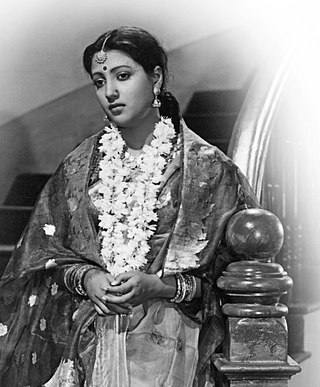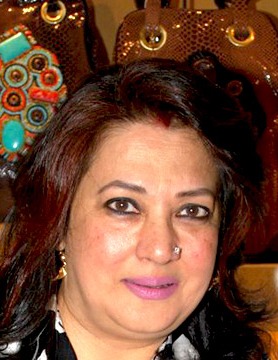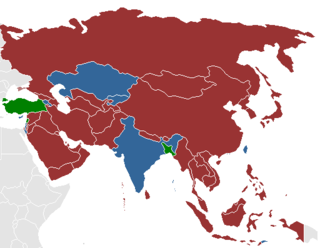Related Research Articles

Kolkata is the capital and largest city of the Indian state of West Bengal. It lies on the eastern bank of the Hooghly River, 80 km (50 mi) west of the border with Bangladesh. It is the primary financial and commercial center of eastern and northeastern India. Kolkata is the seventh most populous city of India with an estimated city proper population of 4.5 million (0.45 crore). It is the centre of the Kolkata Metropolitan Region, one of the most populous metropolitan areas in the world with a population of over 15 million residents. Kolkata is the de facto cultural capital of India and historically and culturally significant city in the historic region of Bengal. It is the second largest Bengali-speaking city in the world. It has the highest number of nobel laureates among all cities in India.

The Mann Act, previously called the White-Slave Traffic Act of 1910, is a United States federal law, passed June 25, 1910. It is named after Congressman James Robert Mann of Illinois.

The University of Calcutta is a public state university located in Kolkata, West Bengal, India. It has 151 affiliated undergraduate colleges and 16 institutes in Kolkata and nearby areas. It was established on 24 January 1857 and is the oldest multidisciplinary university of Indian Subcontinent and South East Asian Region. Today, the university's jurisdiction is limited to a few districts of West Bengal, but at the time of its establishment it had a catchment area ranging from Kabul to Myanmar. Within India, it is recognized as a "Five-Star University" and accredited an "A++" grade by the National Assessment and Accreditation Council (NAAC).

Medical College, Kolkata, also known as Calcutta Medical College, is a public medical college and hospital located in Kolkata, West Bengal, India. It is one of the oldest existing hospitals in Asia. The institute was established on 28 January 1835 by Lord William Bentinck during British Raj as Medical College, Bengal. It is the second oldest medical college to teach Western medicine in Asia after Ecole de Médicine de Pondichéry and the first institute to teach in English language. The college offers MBBS degree after five and a half years of medical training.

The Indian Football Association, abbreviated as IFA, is the organisation that administers association football in the Indian state of West Bengal. It is the oldest Football Association in India and was founded in 1893. Among the founders was former English international Elphinstone Jackson.

Suchitra Sen (Bengali pronunciation:[ʃuːtʃiːraːʃeːn] ; born Roma Dasgupta was an Indian actress who worked in Bengali and Hindi cinema. The movies in which she was paired opposite Uttam Kumar became classics in the history of Bengali cinema.

Moon Moon Sen, also credited as Moonmoon Sen, is an Indian actress, known for her works in Hindi, Bengali, Malayalam, Kannada, Telugu, Tamil, and Marathi films. She eventually starred in Bollywood films. She has appeared in 60 films and 40 television series. She has received Andhra Pradesh state Nandi Award for Best Supporting Actress in 1987, for her role in the film Sirivennela.
Sonagachi is a neighbourhood in Kolkata, India, located in North Kolkata near the intersection of Jatindra Mohan Avenue with Beadon Street and Sovabazar, about one kilometer north of the Marble Palace area. Sonagachi is among the largest red-light districts in Asia with several hundred multi-storey brothels residing more than 16,000 commercial sex workers.

Prostitution is legal in India, but a number of related activities including soliciting, kerb crawling, owning or managing a brothel, prostitution in a hotel, child prostitution, pimping and pandering are illegal. There are, however, many brothels illegally operating in Indian cities including Mumbai, Delhi, Kolkata, Bangalore, and Chennai. UNAIDS estimate there were 657,829 prostitutes in the country as of 2016. Other unofficial estimates have calculated India has roughly 3–10 million prostitutes. India is widely regarded as having one of the world's largest commercial sex industry. It has emerged as a global hub of sex tourism, attracting sex tourists from wealthy countries. The sex industry in India is a multi-billion dollar one, and one of the fastest growing.
Sanlaap is an Indian feminist non-governmental organisation, established by Indrani Sinha in 1987 in Calcutta. Based in Calcutta, the group aims to protect the human rights of women and girls. Sanlaap is a developmental organisation that works towards correction of social imbalances which present themselves as gender injustice and violence against women and children. The primary work is focused against trafficking of women and children for commercial sexual exploitation, sexual abuse and forced prostitution. As part of its work, the group starts shops to train girls to make a living and foster their independence.

The culture of West Bengal is an Indian culture which has its roots in Bengali literature, music, fine arts, drama and cinema. Different geographic regions of West Bengal have subtle as well as more pronounced variations between each other, with Darjeeling Himalayan hill region and Duars showing particularly different socio-cultural aspects.

The Durbar Mahila Samanwaya Committee, or simply Durbar, is a collective of 60,000 sex workers in West Bengal. Established on 15 February 1992, in Sonagachi, the largest red-light district in Kolkata, West Bengal, India with estimated 11,000 sex workers, Durbar has been working on women's rights and sex workers' rights advocacy, anti-human trafficking and HIV/AIDS prevention. The Durbar states that its aims are the challenging and altering of the barriers that form the everyday reality of sex workers' lives as they relate to their poverty or their ostracism. Durbar runs 51 free clinics for sex workers across West Bengal, with support from organisations such as the Ford Foundation and the National AIDS Control Organisation (NACO), who also help Durbar in its initiatives like networking, rights protection and creating alternative livelihood for sex workers.

Prostitution in Kolkata is present in different forms and Kolkata's sex industry is one of the largest in Asia. Prostitution may be brothel-based or non-brothel based as in the case of call girls. India is regarded as having one of the largest commercial sex trades globally. Kolkata has many red-light districts, out of which Sonagachi is the largest red-light district in Asia with more than 50,000 commercial sex workers.

Hawkers in Kolkata numbering 275,000 generated business worth ₹ 87.72 billion in 2005. In Kolkata, formerly known as Calcutta, in the Indian state of West Bengal, almost 80 per cent of the pavements are encroached by hawkers and illegal settlers. In many countries, hawkers use pavements or other public places to retail their goods or services but in Kolkata the magnitude has drawn special attention of administrators and law courts.

The Noakhali riots were a series of semi-organized massacres, rapes and abductions, combined with looting and arson of Hindu properties, perpetrated by the Muslim community in the districts of Noakhali in the Chittagong Division of Bengal in October–November 1946, a year before India's independence from British rule.

India has a very high volume of child trafficking. As many as one child disappears every eight minutes, according to the National Crime Records Bureau. In some cases, children are taken from their homes to be bought and sold in the market. In other cases, children are tricked into the hands of traffickers by being presented an opportunity for a job, when in reality, upon arrival they become enslaved. In India, there are many children trafficked for various reasons such as labor, begging, and sexual exploitation. Because of the nature of this crime; it is hard to track; and due to the poor enforcement of laws, it is difficult to prevent. Due to the nature of this crime, it is only possible to have estimates of figures regarding the issue. India is a prime area for child trafficking to occur, as many of those trafficked are from, travel through or destined to go to India. Though most of the trafficking occurs within the country, there is also a significant number of children trafficked from Nepal and Bangladesh. There are many different causes that lead to child trafficking, with the primary reasons being poverty, weak law enforcement, and a lack of good quality public education. The traffickers that take advantage of children can be from another area in India, or could even know the child personally. Children who return home after being trafficked often face shame in their communities, rather than being welcomed home.
Ashoka Gupta was an Indian freedom fighter and social worker. She was the founder of Mahila Seva Samity, member of the All India Women's Conference and president of Indian Society for Sponsorship and Adoption. She took part in rescue and relief operation during the Noakhali genocide.
Romola Sinha (1913–2010) was a women's right and social activist from Bengal, Calcutta, India.
Hannah Sen (1894–1957) was an Indian educator, politician, and feminist. She was a member of the first Indian Rajya Sabha from 1952 to 1957 and the president of the All India Women's Conference in 1951–52. She was a founder and the first director of Lady Irwin College in Delhi. She also represented India at the UN Commission on the Status of Women and at UNESCO, and was an advisor to the Indian government on the rehabilitation of women and children refugees after the Partition of India.
References
- 1 2 "Social welfare organization working for women empowerment and rehabilitation". All Bengal Women's Union. Archived from the original on 29 January 2018. Retrieved 28 January 2018.
- ↑ "All Bengal Women's Union". End Slavery Now. Retrieved 28 January 2018.
- ↑ "All Bengal Womens Union". Grassroots Volunteering. Retrieved 28 January 2018.
- ↑ Legg, Stephen (2014). "Anti-Vice Lives: Peopling the Archives of Prostitution in Interwar India" (PDF). University of Nottingham. Archived from the original (PDF) on 29 January 2018. Retrieved 28 January 2018.
- ↑ Sen, Samita (11 January 2007). "75 Years IN The Shadow Of Sita". The Telegraph. Archived from the original on 29 January 2018. Retrieved 28 January 2018.
- ↑ The Bengal Suppression of Immoral Traffic Act, 1933 . Retrieved 28 January 2018– via Internet Archive.
- ↑ "Where Charity begins". The Telegraph. 11 January 2011. Archived from the original on 4 March 2016. Retrieved 28 January 2018.
- ↑ "Sponsorship for health and education of the poor children". All Bengal Women's Union. 24 July 2011. Archived from the original on 24 July 2011. Retrieved 28 January 2018.